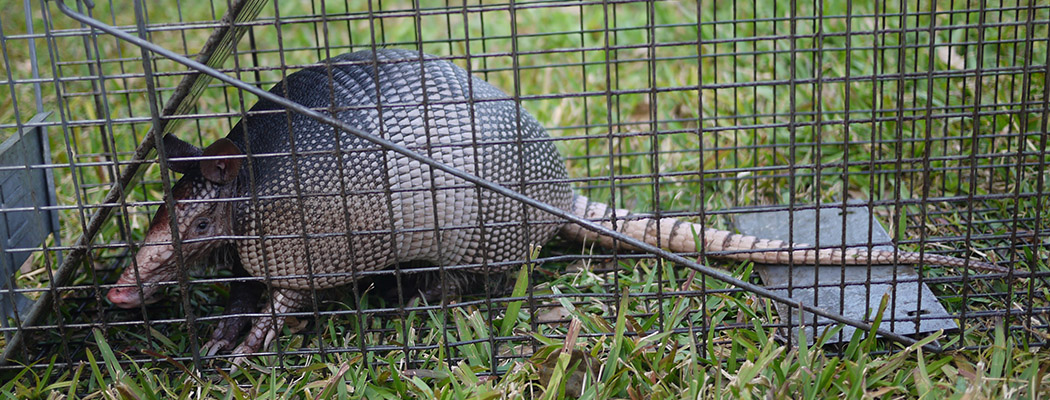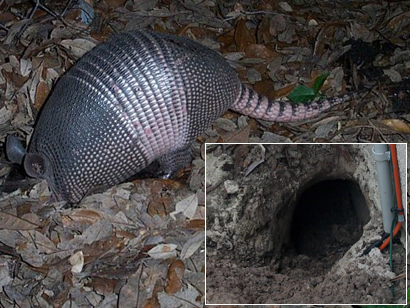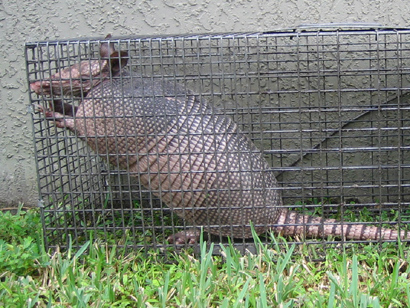- Armadillo Removal - Information about the humane trapping and removal of armadillos.
Armadillo Removal
COMMON PROBLEMS: Armadillos are not indigenous to the United States, but they were transplanted here, and are now common throughout the southern USA. They are excellent diggers, and they will often dig a large burrow next to a house, displacing a lot of dirt. They usually dig several different burrows in a given area. They also dig up a lawn in their nightly search for worms and grubs. They cause some of the following problems:
- Digging one or more large burrows on the property, including next to houses, or under concrete walks or foundations, which can undermine the structure.
- Digging many holes throughout the lawn, in their search for earthworms and grubs.
GENERAL ARMADILLO TRAPPING: Armadillo trapping is subject to state laws regarding capture and relocation or euthanization of wildlife. If you have unwanted armadillos outside the home, in some cases, the only fix is to trap and remove the nuisance wildlife. We can safely, legally, and effectively catch and remove your nuisance armadillos. Trapping is an art, and most amateur attempts go awry for a variety of reasons. An intimate knowledge of armadillo behavior, both prior to and after trapping, and of various armadillo trap types is necessary to ensure that the skunk is trapped and removed without incident.
- STEP 1: Determine if trapping is necessary, or if there is a preventative alternative.
- STEP 2: Select the right trap for the situation, of at least a dozen types of armadillo traps.
- STEP 3: Set the traps in the correct areas, in the shade, camouflaged, on a flat sturdy surface, away from any obstructions or areas that can be damaged, etc.
- STEP 4: No bait is necessary, or even helpful. But placement and presentation of the trap is crucial.
- STEP 5: Monitor the trap daily, remove trapped armadillos.
Learn some additional tips on my How To Get Rid of Armadillos Yourself page - more armadillo removal tips and methods.
Read about how to Trap Armadillos in cage traps.
Armadillo Prevention - Preventative methods for how to keep armadillos away from your property.
How to Kill an Armadillo - Does poison work to kill armadillos? Is killing armadillos the best approach?
Armadillo Repellent - Analysis of various armadillo deterrents and repellent products.
Are Armadillos Dangerous - To pets or people via diseases or attack?

Nine Banded Armadillo Information
Description:
The nine banded armadillo has a hard rough skin made up of hard dermal plates that gives a banded shell-like appearance. The armadillo is approximately the size of a house cat and measures fifteen to seventeen inches long and weighs anywhere from eight to seventeen pounds. The nine banded armadillo’s tail can reach a length of nearly eighteen inches. The color of the armadillo can be varying shades of gray to brown. The three sections of dermal plates that make up the exterior barrier of the armadillo are all adjoined by a soft skin that connects and lies beneath the overlapping bands. The tail is made up of a series of twelve to fifteen rings of dermal plates. Armadillos have short stubby legs with long curved claws for digging, long ears, and snout noses like that of a pig.
Habitat:
Armadillo species can be found in Peru, Northern Argentina, Grenada, Trinidad and Tobago, South America, Central America and south central and southeastern USA. Many armadillo species are endangered animals. Armadillo species can live in many diverse environments and climates such as brush, woods, shrub, grassland, forest, rainforests and tropical forests. The nine banded armadillo is found primarily in the south central area of the United States; most frequently in Texas, but has been known to reach as far as Nebraska, Illinois and Indiana. The expansion of the armadillo across the US is most notably because of a lack of natural predators for these animals. Although they don’t appear to be a water friendly animal, they are actually very good swimmers and prefer to live near water sources.
Food:
The nine banded armadillo’s primary diet consists of grubs, ants, small reptiles, birds, termites and even some berries and fruits. The diet is consistent with what is available most abundantly based on the location of the armadillo species. They are expert diggers and use there impressive claws both for making burrows to live and in scavenging for food underground. This aspect of the armadillo is often what causes trouble with humans who don’t want their yards dug up.
Predators:
A sad but realistic fact is that the armadillo’s primary predator is automobiles. The natural predators that exist for armadillos are Black Bears, Coyotes, Bobcats, Raccoons, Foxes and Dogs.
Social Structure:
The nine banded armadillo is a nocturnal animal. They primarily use their keen sense of smell when foraging. Armadillo’s sleep and hide in burrows, which they usually dig in damp or loose soil. The burrows are often shared by several armadillos or sometimes other animals will take up home there as well; however, not usually at the same time. Armadillos are loners. Nine banded armadillos are not territorial animals, they defend themselves by hiding or running away, but they don’t attack other animals or humans when frightened.
Disease:
Because of the armadillos naturally low body temperature they have been used in studies as subjects for leprosy. Armadillos are one of the rare non-human species that can easily contract the leprosy virus. Humans can acquire the leprosy bacterium from handling them or from consuming armadillo meat. The armadillo can also carry Chagas disease.
Offspring:
Armadillo have a gestation period of two to six months (depending on the species). Most give birth to four young each pregnancy; they are almost always produced from only a single fertilized egg. Some species have litters that can consist of one to eight offspring. All four offspring are nearly always the same sex and are identical quadruplets. Armadillos are the only mammals that can reproduce in this way regularly. Armadillo mothers give birth in their burrow usually in March of each year. Young Armadillos reach maturity at 12 weeks. The young have soft leathery skin at birth which will harden in a few weeks.
Armadillo Nuisance Concerns:
Armadillos have strong, powerful claws and can dig deep burrows along fences, sides of the house and even under the foundation. These burrows can weaken the top ground so that gardens can collapse. They can even cause damage to the foundations of homes depending upon the burrow and its location.



